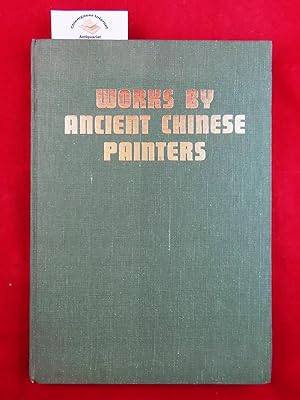HAO TIEN, HO PREFACE (4 resultados)
Tipo de artículo
- Todo tipo de artículos
- Libros (4)
- Revistas y publicaciones
- Cómics
- Partituras
- Arte, grabados y pósters
- Fotografías
- Mapas
-
Manuscritos y
coleccionismo de papel
Condición
- Todo
- Nuevos
- Antiguos o usados
Encuadernación
- Todo
- Tapa dura (3)
- Tapa blanda
Más atributos
- Primera edición (2)
- Firmado
- Sobrecubierta (1)
- Con imágenes del vendedor (1)
- Sin impresión bajo demanda
Ubicación del vendedor
Valoración de los vendedores
-
The Prints Of Shiou-ping Liao
Publicado por Taipei, China, 1982
Librería: Midtown Scholar Bookstore, Harrisburg, PA, Estados Unidos de America
Hardcover. Condición: Very Good. in slipcase - light shelfwear, NICE! Oversized.
-
The Prints Of Shiou-ping Liao
Publicado por Taipei, China, 1982
Librería: CorgiPack, Fulton, NY, Estados Unidos de America
Libro
Hardcover. Condición: VG. Illustrated in color and black & white. From the Foreword: Printing is one of China's four greatest discoveries, so it can be said that the graphic arts are part of our artistic tradition. In the earliest printed work now extant-the title page of the Diamond Sutra, printed in the fourteenth year of the T'ang Hsien-t'ung reign, or A.D. 869-the general appearance of the art of printing is apparent. In meeting the needs and growth of folkloric art and painting albums, for example, the graphic art of China, and especially woodblock prints, reached their apex. Because of this, when speaking of this type of art, China is always mentioned as its birthplace. It is a pity then that after the end of the Ch'ing dynasty that the graphic arts stagnated. In the West, though, the earliest woodblocks were not made until after the fourteenth century, which were replaced in the fifteenth century with copperplates. Lithography was developed in the eighteenth century and was followed by serigraphy. The types of printing techniques multiplied and improved and their use expanded, until today in the graphic arts are some of the finest and most powerful forms of art. China's printed art fell far behand in the meantime, so that with the revitalization of China's beautiful heritage, we hurried to catch up with the West. Today we have this internationally known graphic artist Liao Shiou-ping: his contributions and determination have now made him the greatest printmaker in China. Mr. Liao was born into the home of traditional architects. His youthful years were spent surrounded by the intricately beautiful shapes found in Chinese architecture and gave him his first stirrings of imagination. In addition to this, his childhood home was near the old Lung-shan Temple in Taipei, the ceremonies and devotions of which deeply influenced him. When he was a young man he entered the art department of National Taiwan Normal University and studied oil painting, printing, watercolors, and the art theories of the West. Upon graduating, Mr. Liao decided to further pursue his studies of Western art, and in 1962 went to Japan. At the Tokyo University of Education, Mr. Liao absorbed the flourishing fascination there with graphic art, and took upon himself the responsibility of helping to further the development of this traditionally Chinese art form. His devotion to this art form led his work to be shown in Brazil's "Bienal de Sao Paolo" exhibition in 1963, and to win first prize in 1964 from the "Sigenkai Art Exhibition" in Tokyo. With these acknowledgements of his young talent as encouragement, Mr. Liao entered Paris' Ecole National Superieure des Beaux-Arts and Atelier 17 to study Western oil painting and graphics. Prints made with Western copperplate techniques have very delicate lines and good color, making them very appropriate for bringing back the memories of temples and one's childhood. Because more than one color can be used on a plate, and because its wonderful prints, Mr. Liao found a new direction inspiration and for his creations, and his artworks won him medals from the Conseil General de la Seine et Oise and the Salon des Artistes Francais. In 1968 he decided to live in New York and to enter the artistic training center of the New World. Once in New York, Mr. Liao made up his mind to become a professional graphic artist. He felt that his command of one or two types of printing forms was not enought, so he enrolled in the Pratt Graphic Art Center. In addition to learning more about the various printing techniques, he also met numerous graphic artists and learned from their experiences. 128 pages.
-
Works by Ancient Chinese Painters.
Librería: Fahrenheit 451 Antiquarian Booksellers, Leiden, Holanda
Original o primera edición
No place, National Museum of History. 1977, 1st ed., no pagination, 79 plates, full colour and black and white illustrations. English and Chinese text, original cloth with dustjacket, folio.
-
Works by Ancient Chinese Painters. English and Chinese text
Publicado por National Museum of History, 1977
Librería: Chiemgauer Internet Antiquariat GbR, Altenmarkt, BAY, Alemania
Libro Original o primera edición
Originalleinen. Folio. Condición: Wie neu. First edition. No pagination, 79 plates, full colour and black and white illustrations. FRISCHES, SEHR schönes Exemplar der ERSTAUSGABE. In excellent shape. Sprache: Englisch Gewicht in Gramm: 1500.



